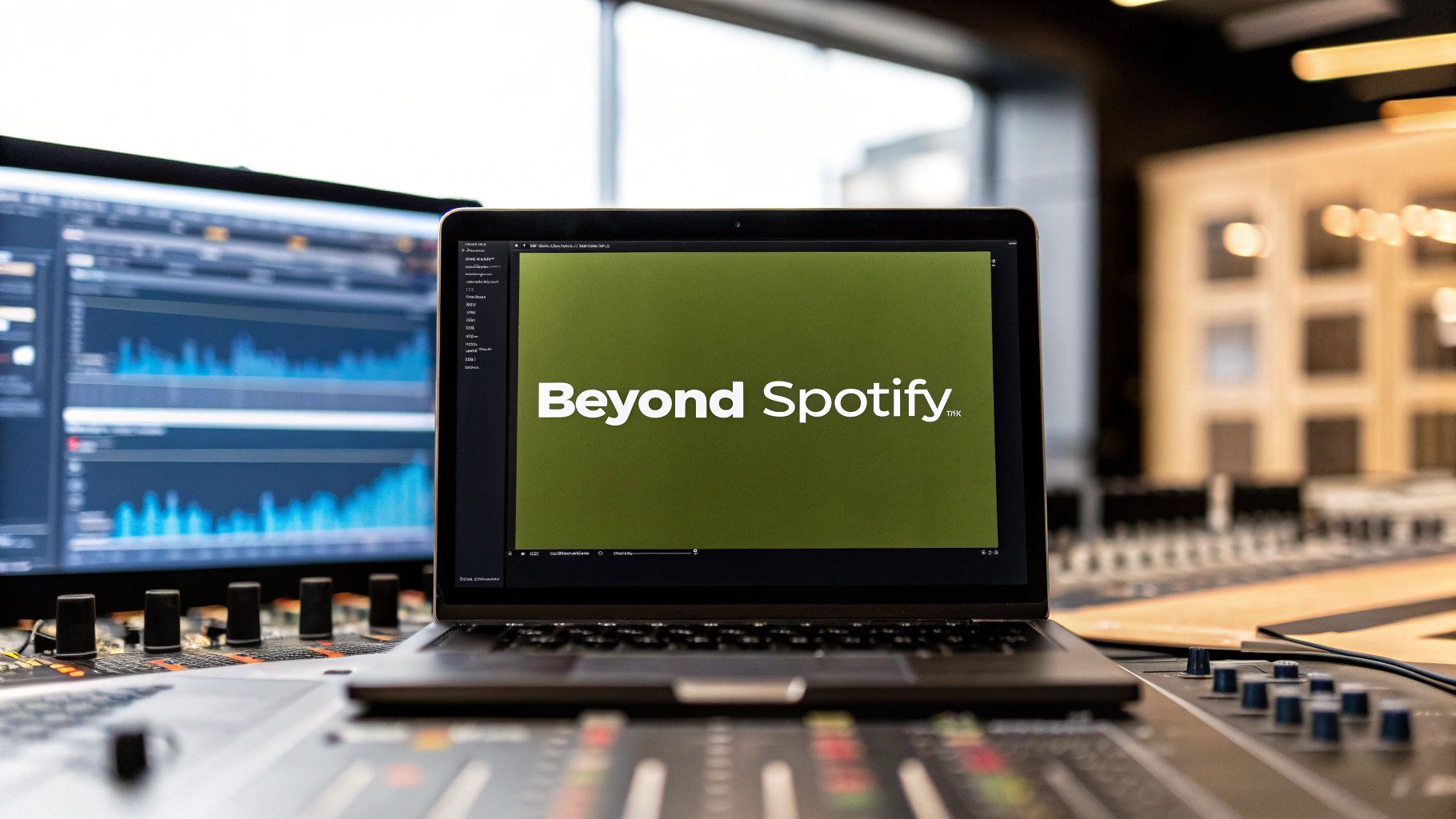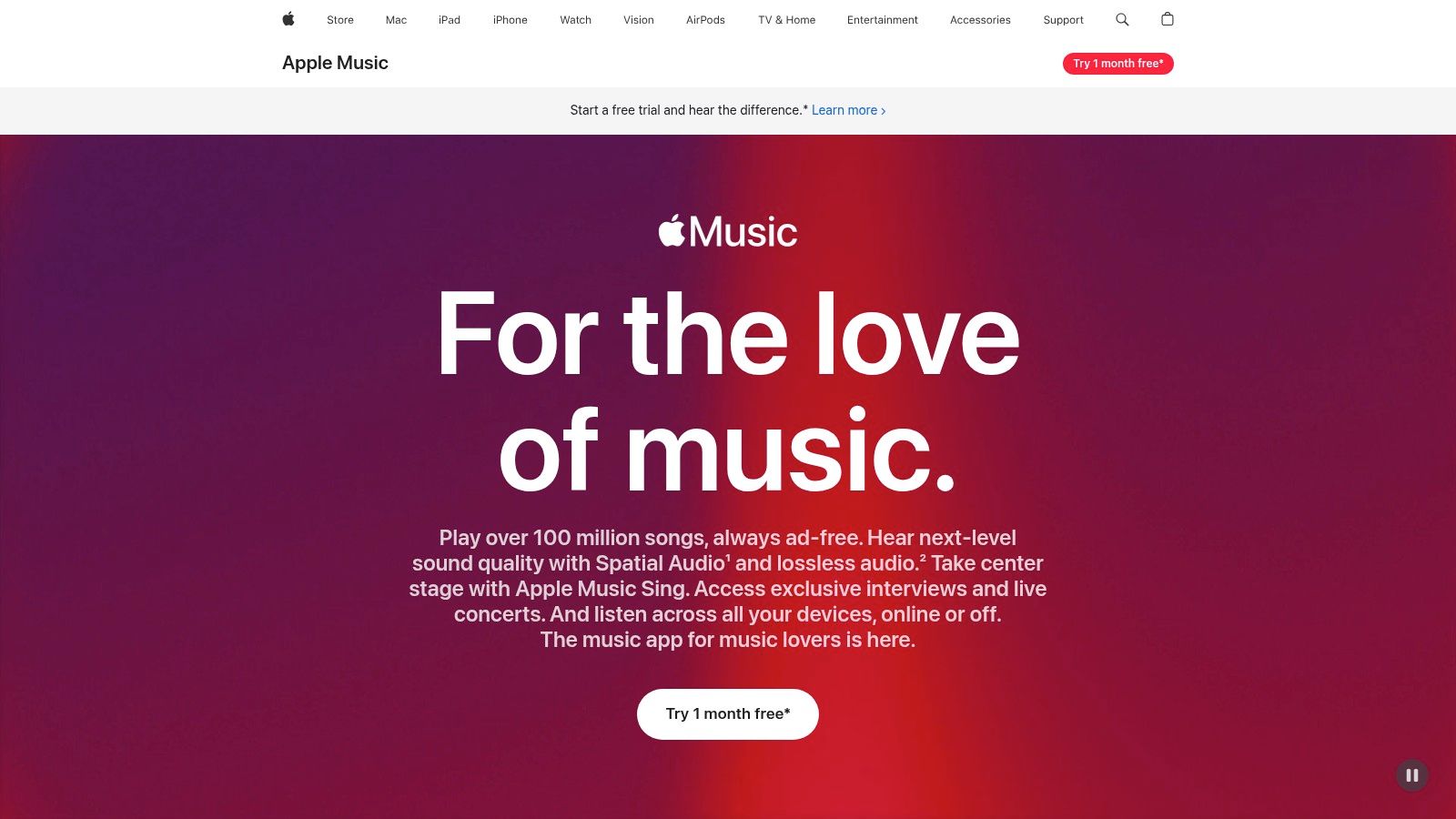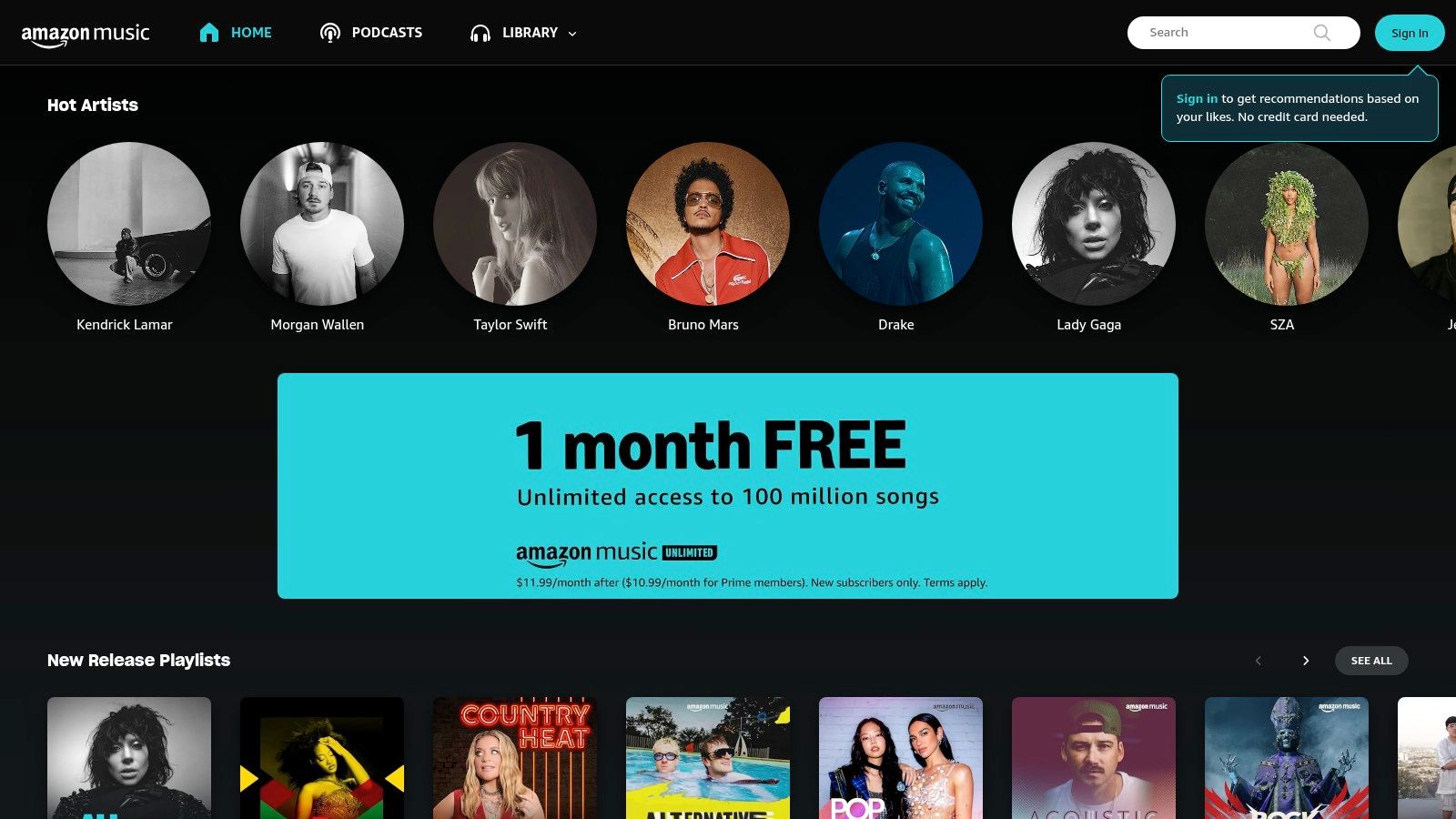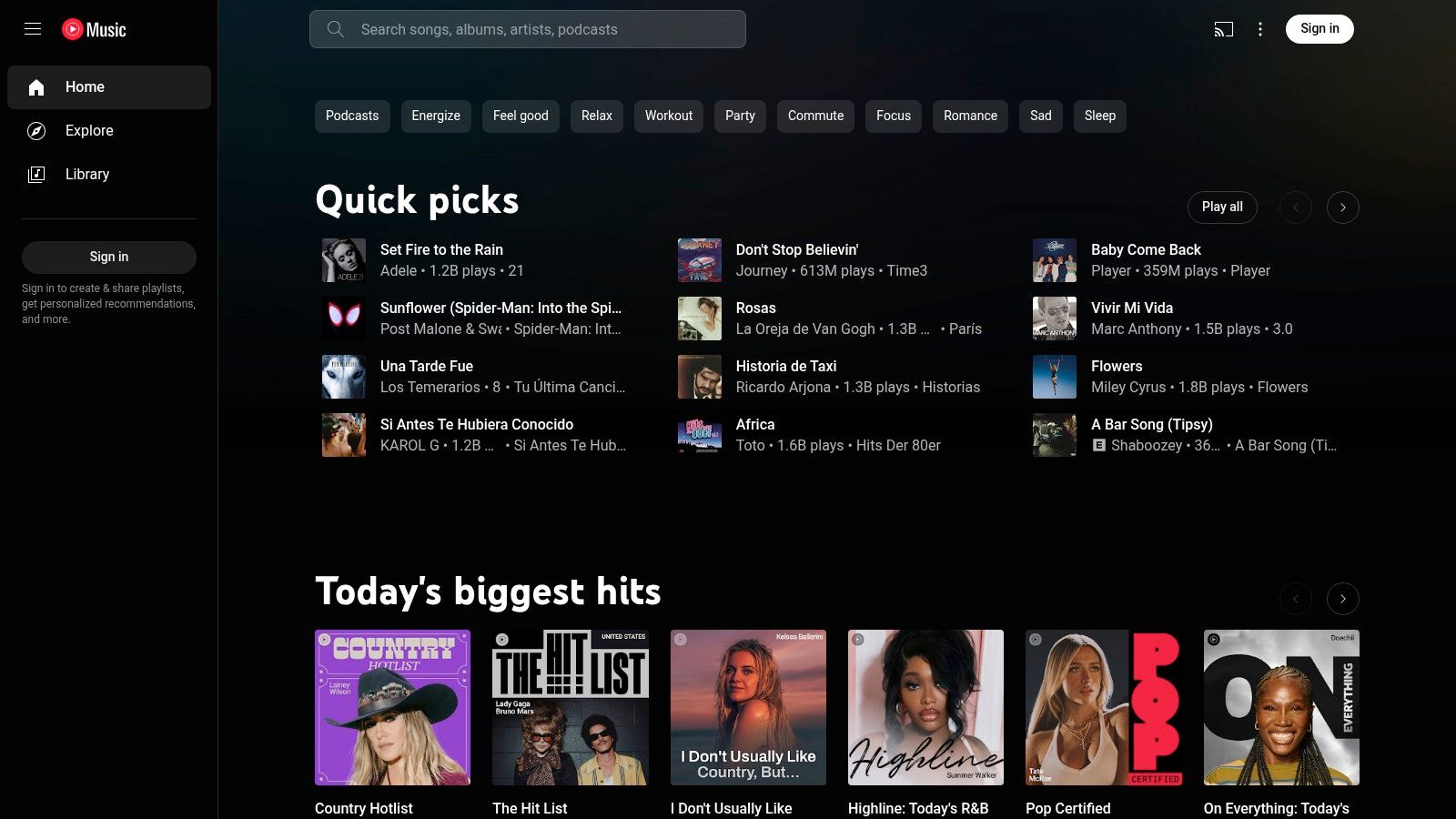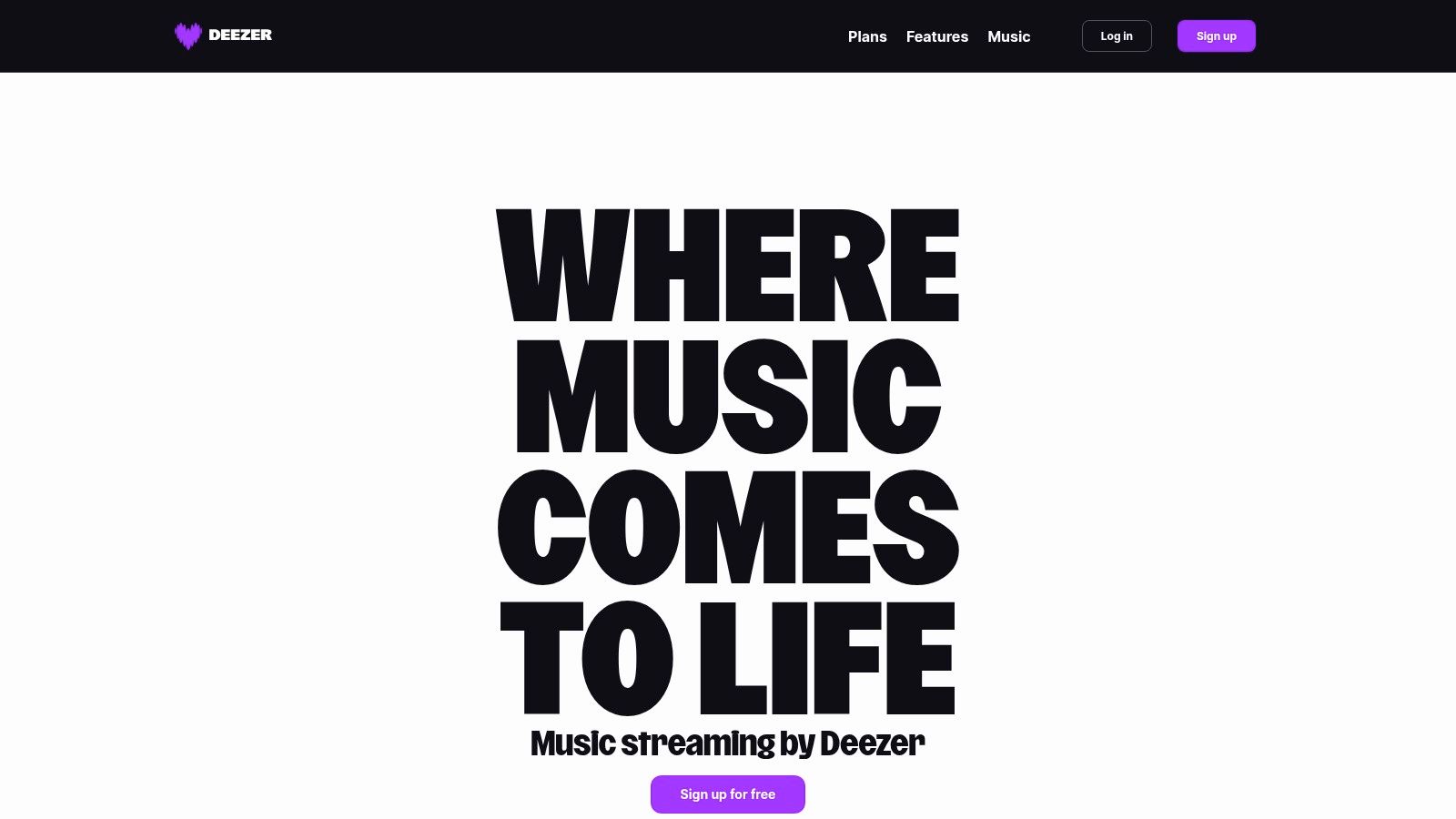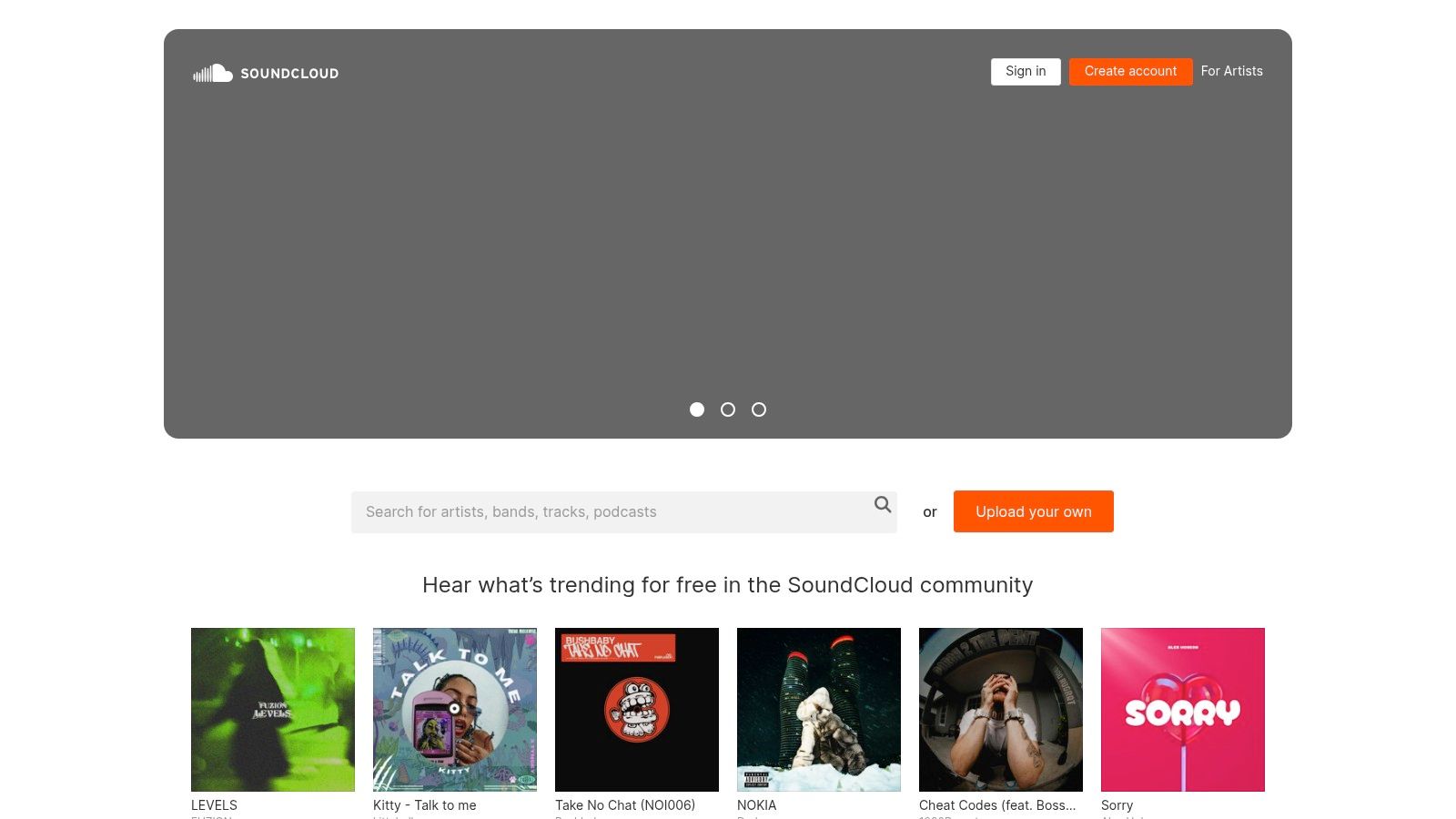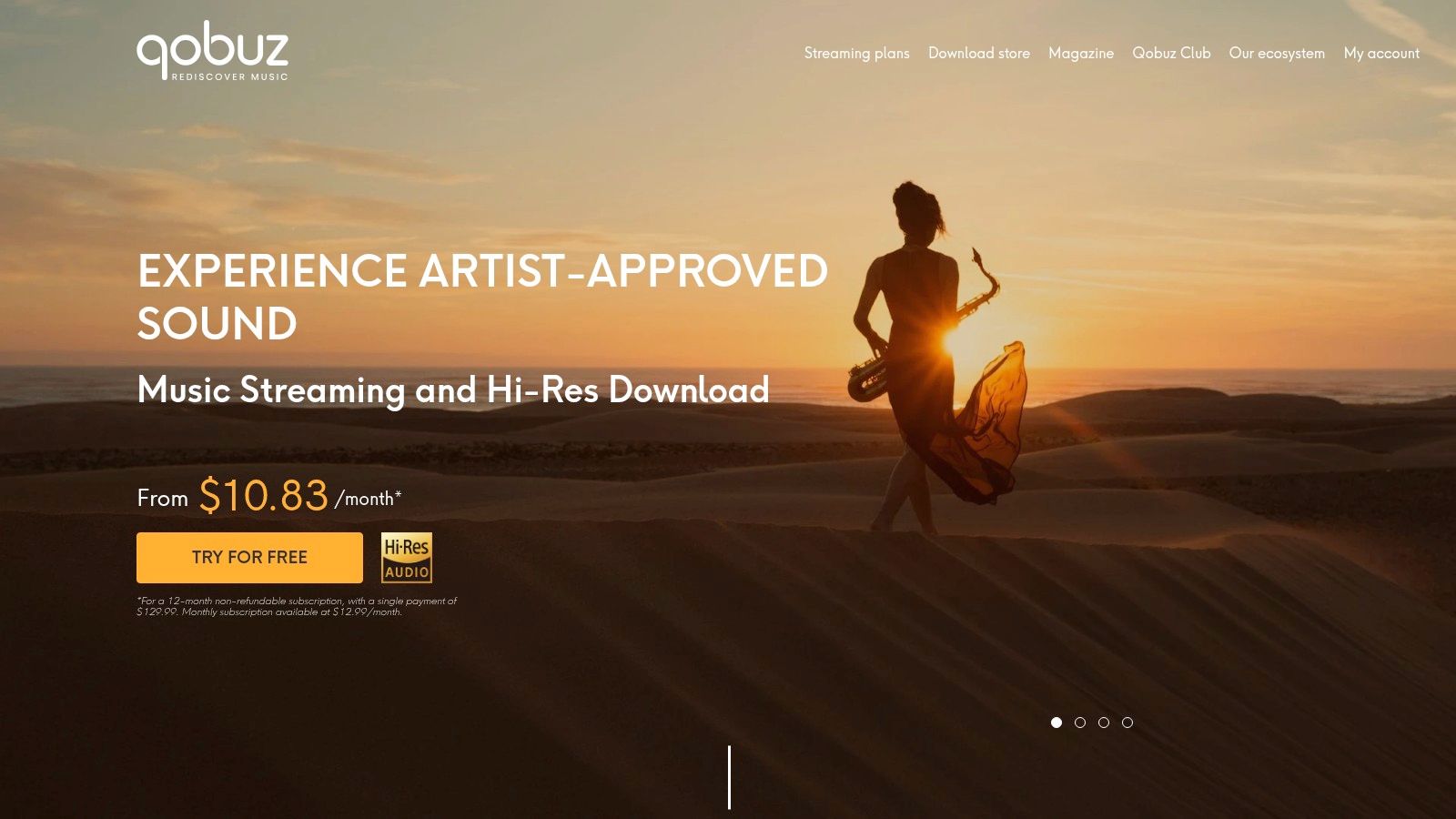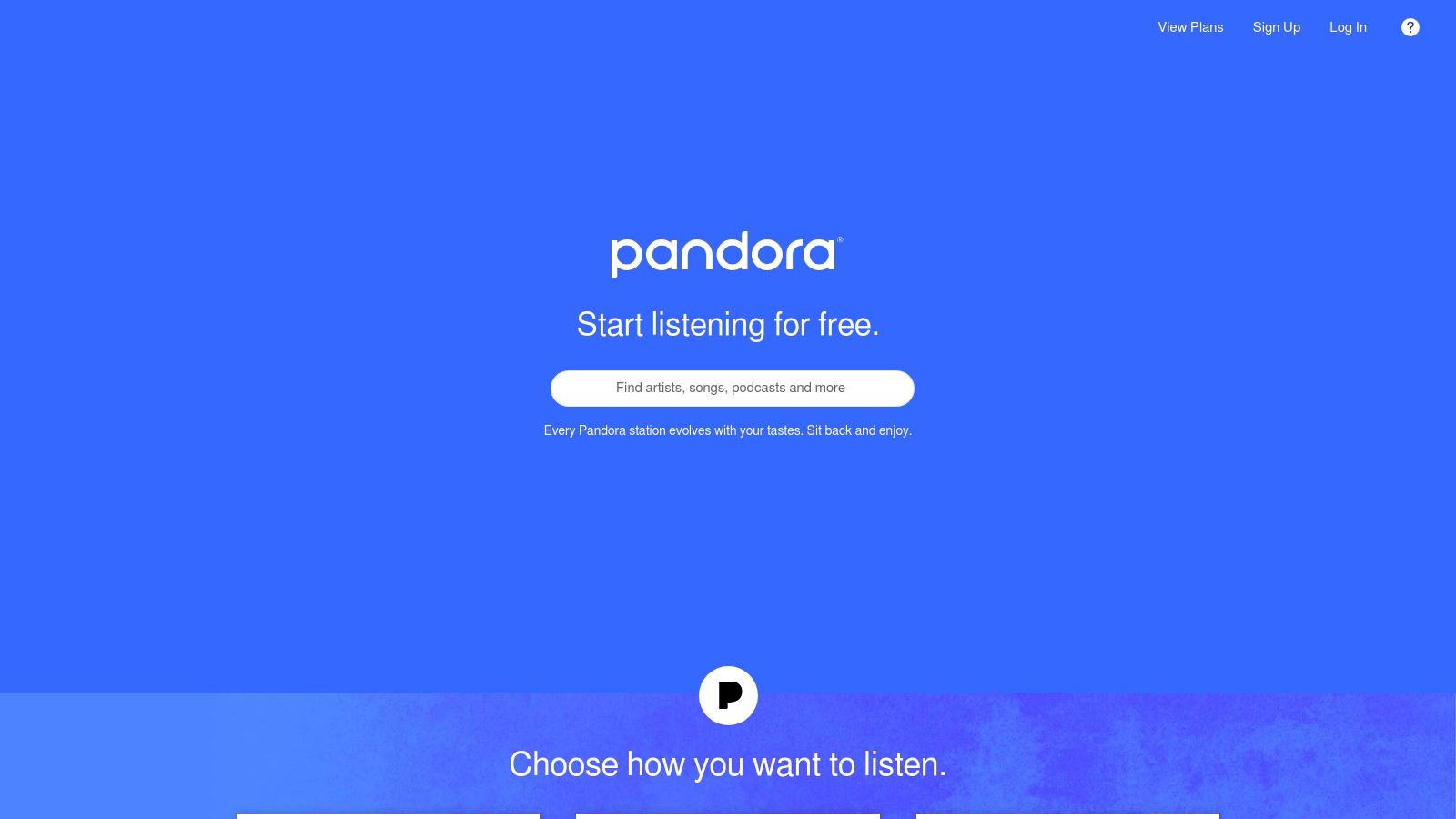Beyond Spotify: Exploring Your Music Streaming Options
Spotify has become a dominant force in music streaming. But in 2025, a diverse range of alternatives cater to various needs and preferences. Are you passionate about high-quality audio? Perhaps you're looking for more podcasts or a platform that supports artists fairly. Maybe you're just curious about other options. Your choice of music streaming service significantly impacts your listening experience, from audio fidelity and discovery to offline playback and device integration.
This curated list explores eight strong Spotify competitors, each with unique features and benefits. We'll examine key decision-making factors: audio quality (standard to hi-fi and lossless), music library size and variety, pricing and family plans, platform compatibility (iOS, Android, desktop, and smart speakers), and unique features like offline listening, personalized recommendations, and social sharing.
Understanding these nuances helps you select the perfect platform to enhance your music streaming. By the end of this article, you'll have a comprehensive understanding of the top Spotify alternatives and be prepared to make an informed choice based on your individual needs. Get ready to discover your next favorite music streaming service.
1. Apple Music
Apple Music stands as a major player in the music streaming world, offering a vast library of over 100 million songs. Its emphasis on high-fidelity audio, combined with seamless integration within the Apple ecosystem, makes it an attractive option for both audiophiles and Apple device users. Whether you're seeking lossless audio, crafting the perfect workspace ambience, or researching music trends, Apple Music provides a rich and immersive listening experience.
A key distinguishing feature of Apple Music is its dedication to superior audio quality. With lossless audio and Spatial Audio with Dolby Atmos support, you can experience music with exceptional depth and clarity, precisely as the artists intended. This is particularly noticeable for those using high-quality headphones or speakers.
The platform also shines in its curated playlists, often meticulously crafted by human experts across a wide spectrum of genres and moods. This personalized approach differentiates it from services relying solely on algorithms. Live radio stations, such as the prominent Apple Music 1, further enrich the content available.
For those deeply integrated into the Apple world, the smooth integration with other Apple devices is a significant benefit. Control playback effortlessly across your iPhone, iPad, Mac, and HomePod. Time-synced lyrics elevate the listening experience, letting you follow along with your favorite tracks. Apple Music also provides attractive family sharing plans, making it an economical choice for families.
Areas for Improvement
While Apple Music excels in audio quality and curation, it does have some limitations. The web player's functionality is less robust compared to competitors like Spotify, and the user interface may feel less intuitive to those transitioning from other platforms. While personalized recommendations are offered through the 'Listen Now' section, its discovery algorithms are generally considered less refined than Spotify's. Lastly, unlike some rivals, Apple Music doesn't offer a free tier.
Features:
- Over 100 million songs in lossless audio quality
- Spatial audio with Dolby Atmos support
- Live radio stations including Apple Music 1
- Time-synced lyrics
- Seamless integration with Apple ecosystem
Pros:
- High-quality lossless audio and Dolby Atmos support
- Expertly curated, human-created playlists
- Strong integration with Apple devices
- Cost-effective family sharing plans
Cons:
- Limited web player functionality
- Less intuitive user interface compared to some competitors
- Discovery algorithms less sophisticated than Spotify's
- No free tier available
Pricing: A range of individual and family plans are available. Check the Apple Music website for current pricing details in your region.
You might be interested in: Our sitemap for more resources on tech tools and platforms.
Website: https://www.apple.com/apple-music/
Apple Music secures its spot on this list by delivering a premium, high-fidelity listening experience, particularly for users already within the Apple ecosystem. While it may not be ideal for everyone, its dedication to audio quality and expertly curated content positions it as a strong alternative to other music streaming services.
2. Amazon Music
Amazon Music stands as a strong competitor to Spotify, providing a comprehensive music catalog and a tiered service model. This structure caters to various listening habits and budgets, making it especially attractive for those already within the Amazon ecosystem.
Whether you're a casual listener or a dedicated audiophile, Amazon Music likely has a tier to suit your needs. Amazon Music Prime, included with an Amazon Prime membership, offers ad-free listening to 2 million songs, along with thousands of stations and playlists. This tier is perfect for background music while working or commuting, a considerable improvement over traditional radio without needing a separate music subscription.
For a more extensive library, Amazon Music Unlimited provides access to over 100 million songs, comparable to Spotify's catalog, and adds offline listening capabilities. And for the true audiophile, Amazon Music HD delivers lossless, high-definition audio (HD and Ultra HD) along with spatial audio, rivaling the quality of Tidal. This high-fidelity option is an excellent choice for those who appreciate superior sound on high-end headphones or speaker systems.
Features
- Multiple subscription tiers: Free (limited selection, ad-supported), Prime (included with Amazon Prime), Unlimited, and HD/Ultra HD.
- HD and Ultra HD audio quality options (Unlimited and HD tiers).
- Alexa voice control integration: Control playback seamlessly using voice commands on Alexa-enabled devices.
- Podcast support: Listen to a broad selection of podcasts within the app.
- X-Ray lyrics feature: View lyrics synchronized with the music in real time.
Pros
- High-quality audio options: HD and Ultra HD provide a superior listening experience.
- Discounted rates for Prime members: Amazon Music Prime offers significant value for current Prime subscribers.
- Excellent voice control with Alexa: Manage music effortlessly with simple voice commands.
- Bundling options with other Amazon services: Simplifies subscriptions and billing.
Cons
- Less intuitive interface: Navigation and music discovery can feel less user-friendly compared to Spotify or Apple Music.
- Weaker social features: Sharing and connecting with friends isn't as well-developed.
- Limited music discovery tools: Playlists and recommendations exist, but they are not as refined as Spotify's algorithmic features.
- Content availability varies across tiers: The different catalogs for each tier can be confusing.
Pricing (as of October 2023, subject to change)
- Amazon Music Prime: Included with Amazon Prime membership ($14.99/month or $139/year).
- Amazon Music Unlimited: $9.99/month for non-Prime members, $8.99/month for Prime members.
- Amazon Music HD: $14.99/month for non-Prime members, $12.99/month for Prime members.
Technical Requirements
Available on iOS, Android, web browsers, desktop app, and various smart devices including Amazon Echo devices, Sonos, and more.
Implementation Tip
Amazon Music offers exceptional convenience for owners of Alexa-enabled devices. Setting your preferred tier in your Amazon account allows hands-free music control, making it a great choice for home or office use.
Website
Amazon Music is a serious contender in the music streaming landscape. Its strengths lie in its tiered options, high-fidelity audio, and seamless integration with the Amazon ecosystem. While the interface and discovery features have room for improvement, competitive pricing and the value proposition, particularly for Prime members, make it a viable alternative to Spotify.
3. YouTube Music
YouTube Music stands as a strong competitor to Spotify, boasting a massive library that blends traditional audio with YouTube's extensive video collection. This integration offers unique advantages for a wide range of users, from casual listeners to dedicated music fans. Imagine seamlessly switching from listening to a song to watching its official music video, a live performance, or even a fan cover – all within the same platform. This versatility is the core strength of YouTube Music.
Exploring YouTube Music's Diverse Content
For tech enthusiasts and digital marketers, YouTube Music offers a valuable resource. Discovering emerging artists, understanding music trends, and identifying potential influencers for campaigns becomes significantly easier. The platform's smart search, capable of finding songs based on lyrics or even vague descriptions, is a powerful tool for research and content curation.
Productivity and Convenience
Business professionals and remote workers can use YouTube Music's background playback and offline downloads (with the Premium subscription) to enhance focus and productivity. Personalized playlists like "Your Mix" and "Discover Mix" offer a tailored listening experience adaptable to various work settings. Integration with Google Assistant provides convenient hands-free control.
Content for Entertainment Consumers
Streaming and entertainment consumers will appreciate the wide array of content. Beyond official releases, discovering live performances, remixes, and covers adds a new dimension to music exploration. The readily available music videos also cater to those who prefer a more visual music experience.
Pricing and Availability
YouTube Music offers a free, ad-supported tier and a premium subscription called YouTube Music Premium. YouTube Premium, which includes YouTube Music Premium, provides ad-free access to both YouTube and YouTube Music, alongside background playback and offline downloads. Pricing is region-dependent.
Technical Requirements and Key Features
YouTube Music is accessible through a web browser and dedicated mobile apps for Android and iOS.
- Combined audio and video library: Access millions of songs, albums, music videos, live performances, and more.
- Smart search: Find songs based on lyrics, descriptions, or even general themes.
- Background playback and offline downloads (Premium): Listen uninterrupted, even with the app closed or offline.
- Personalized playlists: Explore new music with curated mixes tailored to your listening habits.
- Seamless Google Assistant integration: Control playback using voice commands.
Pros and Cons of Using YouTube Music
Here's a quick breakdown of the advantages and disadvantages:
| Pros | Cons |
|---|---|
| Extensive music video library | Less refined user interface |
| Powerful search capabilities | Audio quality not as high as some competitors |
| Included with YouTube Premium | Smaller audio-only catalog (vs. Spotify) |
| Unique content (live shows, covers, etc.) | Playlist management not as robust as Spotify |
Getting Started with YouTube Music
Website: https://music.youtube.com/
If you're a YouTube Premium subscriber, you already have YouTube Music Premium! Simply download the YouTube Music app or access it through your web browser. Free users can explore the ad-supported version to experience the platform before subscribing.
4. Tidal
Tidal distinguishes itself in the competitive music streaming landscape by prioritizing high-fidelity audio and a fairer artist compensation model. If sound quality reigns supreme for you, Tidal is a compelling Spotify alternative worth exploring. This platform caters to audiophiles and music lovers who value lossless audio and supporting artists directly.
Tidal offers two primary subscription tiers: HiFi and HiFi Plus. The HiFi tier provides lossless CD-quality audio (1411 kbps) for $9.99/month, comparable to other standard streaming services like Spotify. However, upgrading to HiFi Plus unlocks Master Quality Authenticated (MQA) tracks (up to 9216 kbps), Dolby Atmos, and Sony 360 Reality Audio for $19.99/month. This premium tier offers a truly immersive listening experience, setting Tidal apart. To fully appreciate these advanced features, you'll need compatible hardware such as high-quality headphones, DACs, and a sound system capable of supporting Dolby Atmos or 360 Reality Audio.
Compared to Spotify, Tidal’s music library is smaller, but it compensates with exclusive content, early album releases, live-streamed concerts, and high-quality music videos. The platform also emphasizes music journalism and curated playlists, offering a more in-depth exploration of music culture. While Tidal's algorithm for personalized recommendations may not be as sophisticated as Spotify's, its focus on editorial content presents a unique approach to music discovery.
For artists and music professionals, Tidal’s direct-to-artist payment model is a key advantage. The platform claims to pay a greater percentage of royalties to artists compared to other streaming services. This emphasis on ethical compensation has attracted several prominent artists to the platform.
Features
- Hi-Fi and Master Quality audio (up to 9216 kbps)
- Dolby Atmos and Sony 360 Reality Audio support
- Direct-to-artist payment model
- Exclusive content and early releases
- Extensive music video library
Pros
- Audiophile-grade sound quality
- Better artist compensation model
- Exclusive content and music documentaries
- Strong editorial content and music journalism
Cons
- Higher subscription cost than mainstream competitors
- Smaller user base resulting in fewer social features
- Less developed algorithm for music recommendations
- Smaller music catalog than some competitors
You might be interested in: Our Sitemap for more articles on different software and platforms.
Tidal earns its spot on this list by offering a distinct alternative to mainstream streaming services. Its commitment to high-fidelity audio and artist-friendly practices resonates with a niche but expanding audience. If you prioritize sound quality and desire a more curated music experience, Tidal is definitely worth checking out. Visit Tidal
5. Deezer
Deezer stands as a strong international competitor to Spotify, offering a compelling alternative. It presents a clean interface, high-quality audio, and robust discovery features for music enthusiasts. With a library of over 90 million tracks, podcasts, and radio channels, Deezer boasts a wealth of content waiting to be explored.
One of Deezer's key features is Flow, a personalized AI-powered soundtrack that adapts to your listening habits. It acts like a personal radio station, constantly playing music suited to your evolving tastes. This feature is particularly beneficial for remote workers or those seeking background music for focused work or relaxation. Beyond Flow, Deezer provides curated playlists and personalized recommendations, further enhancing music discovery. For audiophiles and tech enthusiasts, Deezer's HiFi option (16-bit/44.1kHz) delivers lossless audio streaming for a richer, more detailed listening experience.
Another unique aspect of Deezer is SongCatcher. This tool allows you to quickly identify songs playing around you, similar to Shazam. It's incredibly useful for anyone needing to source music for projects or simply identify a catchy tune. Integrated lyrics within the app let you sing along or explore the meaning behind the music, enhancing the overall user experience.
Deezer provides a variety of subscription plans. These include a free, ad-supported tier and various premium plans with features like offline listening and HiFi audio. Pricing varies by region; check the Deezer website for specific costs in your area. The Deezer app is available on a wide range of devices, including iOS, Android, desktop, and web player, requiring only a stable internet connection.
Pros and Cons of Using Deezer
Here's a quick overview of the advantages and disadvantages of using Deezer:
Pros:
- Intuitive and clean user interface: Navigation is easy, and the visually appealing design enhances enjoyment.
- Strong focus on music discovery: Flow, curated playlists, and SongCatcher offer diverse ways to find new music.
- High-quality audio options: The HiFi subscription provides lossless audio for discerning listeners.
- Good international music catalog: Deezer has a strong global presence and offers a diverse range of music from around the world.
Cons:
- Smaller user base in North America: Deezer's market share is smaller than Spotify or Apple Music in North America.
- Less aggressive with exclusive content: Deezer generally secures fewer exclusive releases than some larger competitors.
- Mobile app can be buggy at times: While generally stable, the mobile app can experience occasional performance issues.
- Fewer third-party integrations than larger competitors: Deezer lacks some integrations found on platforms like Spotify.
Implementation Tip
Begin with the free tier to explore the interface and Flow feature. If you enjoy the experience and want high-quality audio or offline listening, consider upgrading to a premium subscription.
Website: https://www.deezer.com/
6. SoundCloud
SoundCloud distinguishes itself from other Spotify competitors by prioritizing community and user-generated content. It functions as both a streaming service and a creative hub, making it a powerful tool for music discovery. This is especially true for those seeking emerging artists, remixes, DJ sets, and podcasts often unavailable on mainstream platforms.
SoundCloud’s unique value lies in its niche focus. It offers a diverse library of content you won't find on platforms like Spotify or Apple Music. This includes everything from aspiring artists uploading their first creations to established musicians sharing exclusive remixes and live performances. It's a dynamic environment for creators and listeners alike.
Features and Benefits
SoundCloud offers several key features that contribute to its distinctive appeal:
- User-Generated Content and Community Focus: SoundCloud thrives on its active community. Users can upload their own audio, follow their favorite creators, and participate in discussions, fostering a direct connection between artists and fans.
- Direct Artist-to-Fan Interaction: Artists can directly engage with their fanbase by responding to comments, joining conversations, and building a loyal following on the platform.
- Advanced Audio Commenting System: This unique functionality lets users leave comments timed to specific points within a track, encouraging detailed feedback and discussions about the music.
- DJ-Friendly Track Availability: SoundCloud offers a broader selection of DJ mixes and remixes, catering to DJs and electronic music enthusiasts.
- Independent Artist Discovery: The platform acts as a springboard for up-and-coming artists, offering listeners a chance to discover new talent before it reaches mainstream audiences.
Pros and Cons
Here’s a quick overview of SoundCloud’s strengths and weaknesses:
Pros:
- Unique Content: SoundCloud's greatest strength lies in its exclusive content unavailable on other platforms.
- Strong Community: The platform’s community features and direct artist interaction foster a sense of connection and enable meaningful engagement.
- Emerging Artist Platform: It's a fantastic resource for discovering new artists and exclusive remixes.
- Free Tier: A free, ad-supported tier allows users to explore the platform and its community without a paid subscription.
Cons:
- Catalog Organization: The music catalog can feel less organized than major competitors, making music discovery somewhat less efficient.
- Audio Quality: The quality of user-uploaded content can be inconsistent.
- Limited Offline Capabilities: Full offline access requires a paid subscription.
- Playlist Management: Playlist and library management could benefit from improvements in organization and usability.
Pricing and Availability
SoundCloud offers several subscription tiers:
- Free: Ad-supported listening with limited features.
- SoundCloud Go: Ad-free listening and offline playback. Pricing varies by region.
- SoundCloud Go+: Extends the Go features with access to a broader library of high-quality tracks. Pricing varies by region.
SoundCloud is accessible through a web browser and dedicated mobile apps for iOS and Android devices.
Comparison with Similar Tools
While platforms like Bandcamp also support independent artists, SoundCloud differentiates itself through its robust community features and emphasis on user-generated content. Bandcamp focuses more on direct sales and downloads, while SoundCloud highlights streaming and discovery.
Implementation/Setup Tips
Getting started with SoundCloud is easy:
- Create a Profile: Create a profile to follow artists, save tracks, and participate in the community.
- Explore: Use the "Explore" tab to discover new music based on genre, mood, or curated playlists.
- Engage: Leave comments, share tracks, and support your favorite creators.
Website: https://soundcloud.com/
SoundCloud offers a unique listening experience focused on community interaction and music discovery. While it might not have the polished interface or massive catalog of larger streaming services, its emphasis on independent artists and user-generated content makes it a worthwhile platform for any music enthusiast.
7. Qobuz
Qobuz stands out in the crowded music streaming market. It caters to audiophiles and music enthusiasts who prioritize sound quality. If you're tired of compressed audio and want richer, deeper lossless music, Qobuz is worth considering. It's the premier option for high-resolution audio streaming and downloading.
Qobuz blends streaming and downloading. Subscribers can stream high-resolution audio up to 24-bit/192kHz. This surpasses the quality of competitors like Spotify or Apple Music. The difference is especially noticeable with high-fidelity headphones or speakers. You'll hear nuances and details often lost in standard compressed formats. It's like the difference between watching a movie in standard definition and 4K.
Beyond streaming, Qobuz has a digital download store. You can buy and own high-resolution music files. This gives audiophiles a permanent, offline way to build a curated personal library. Owning your music ensures access regardless of your subscription status.
Qobuz offers more than just technical quality. It has extensive editorial content. This includes digital booklets, liner notes, and artist biographies, adding depth to the listening experience. The catalog leans towards classical, jazz, and indie genres. It offers a rich selection often missed by mainstream services. Discovering new music within these genres becomes a real pleasure.
Features
- Hi-Res audio streaming up to 24-bit/192kHz
- Integrated hi-res download store
- Extensive editorial content and digital booklets
- Focus on classical and jazz catalogs
- No MQA compression technology required
Pros
- True lossless and highest-resolution audio quality
- Strong editorial curation and music context
- Option to purchase and own music
- Specializes in niche genres often overlooked by mainstream services
Cons
- Smaller overall catalog than major competitors
- Higher subscription cost (starting around $10.83/month for Studio Premier)
- Limited social features compared to mainstream platforms
- Mobile apps, while functional, are less developed than some competitors
Implementation/Setup Tips
- Invest in high-quality headphones or a sound system to fully appreciate the hi-res audio.
- Explore the editorial content to discover new artists and learn more about the music.
- Consider the download store for building a permanent collection of your favorite albums.
Comparison
Tidal also offers hi-res streaming. However, Qobuz generally offers higher bitrates and focuses on true lossless audio without MQA compression. This focus on pure audio quality sets Qobuz apart.
Website: https://www.qobuz.com/
Qobuz isn't for everyone. Casual listeners might find the higher price and smaller catalog less appealing. But for serious music lovers, audiophiles, and those who prioritize sound quality and curated content, Qobuz offers a superior experience. This justifies the investment. It fills a niche in the market, providing a place for true high-fidelity enjoyment.
8. Pandora
Pandora, a long-standing player in music streaming, sets itself apart with the Music Genome Project. This technology analyzes songs based on hundreds of musical attributes to create personalized radio stations. While Pandora's foundation is built on radio-style streaming, it now offers on-demand listening with its Premium subscription. This makes it a competitor to Spotify, particularly for those who enjoy music discovery and personalized recommendations.
Pandora’s core strength is its effortless personalization. By simply giving a song or artist a "thumbs up" or "thumbs down," the algorithm refines its understanding of your preferences. This creates increasingly accurate stations, perfect for background listening at work, during exercise, or relaxing at home.
Beyond personalized radio, Pandora offers curated playlists and podcasts. It also has a unique "Modes" feature, allowing you to fine-tune station playback. You can shift the focus between popular tracks, deep cuts, and new releases within your chosen genre.
For business professionals and digital marketers, Pandora can be a valuable tool. It helps set the right atmosphere in workspaces or during presentations. Its ease of use and extensive library ensure a consistent flow of background music without constant manual adjustments. Remote workers can also benefit from Pandora’s personalized stations to improve focus and productivity.
Features
- Music Genome Project for personalized recommendations
- Radio-style streaming with personalized options
- Thumbs up/down feedback system
- Podcast integration
- Modes feature for customized station playback
Pros
- Excellent radio-style discovery
- Simple and user-friendly interface
- Strong personalization with minimal user input
- Lower data usage compared to some competitors
Cons
- Smaller on-demand catalog than competitors like Spotify or Apple Music
- Limited availability outside the US
- Fewer premium features compared to major competitors
- Less control over specific song selection in the free tier
While Pandora's on-demand catalog may not be as large as some competitors, its strength lies in its personalized radio experience. If you value discovering new music within your preferred genres and appreciate a streamlined, easy-to-use interface, Pandora is a good choice. For more resources on various tools and platforms, check out our Sitemap.
Website: Pandora
Pandora offers different subscription tiers (Free, Plus, or Premium) to suit various needs. Pricing may vary based on your region and chosen plan. The free tier provides personalized radio with ads, while paid subscriptions unlock on-demand listening, an ad-free experience, and additional features. You can access Pandora through web browsers, mobile apps (iOS and Android), and many smart speakers and connected car platforms.
Spotify Competitor Side-by-Side Comparison: 8 Platforms
| Service | Core Features 🏆 | User Experience ★ | Value Proposition 💰 | Target Audience 👥 | Unique Points ✨ |
|---|---|---|---|---|---|
| Apple Music | Lossless audio, Dolby Atmos, curated playlists, Apple integration | Polished for Apple users; moderate intuitiveness | Premium quality with exclusive content | Apple ecosystem fans | Family sharing, spatial audio |
| Amazon Music | Multiple tiers, HD/Ultra HD, Alexa integration | Functional but less intuitive | Discounts for Prime members | Amazon users, Prime subscribers | Voice control & bundling options |
| YouTube Music | Audio+video library, smart search, offline downloads (Premium) | Strong search & Google Assistant integration | Inclusive value with YouTube Premium benefits | Google/YouTube enthusiasts | Vast music video collection |
| Tidal | HiFi/Master quality, Dolby Atmos, exclusive releases | Audiophile-grade; niche curation | Fair artist compensation with high-fidelity sound | Audiophiles and dedicated music fans | Artist-owned, exclusive live events |
| Deezer | 90M+ tracks, HiFi option, AI-powered Flow | Intuitive, clean interface; good discovery | Global catalog with personalized soundtrack | Global music lovers | SongCatcher feature, continuous Flow |
| SoundCloud | User-generated content, community uploads, independent artist platform | Unique, creative but less organized | Free tier with exposure to emerging music | Independent creators & listeners | Direct artist-fan interaction, exclusive remixes |
| Qobuz | Hi-Res streaming/download, editorial content, niche genre focus | Focused interface for high-quality audio | True lossless quality with purchase options | Audiophiles with niche tastes | Integrated hi-res download store, detailed booklets |
| Pandora | Music Genome-based radio, personalized stations, podcast support | Simple, radio-style; accessible | Low data usage with minimal user input | US-based casual listeners | Unique radio discovery model |
Finding the Perfect Spotify Competitor For You
Choosing the right music streaming service from the many Spotify competitors can be overwhelming. This guide helps you navigate the options and find the perfect platform for your needs in 2025 and beyond. Whether you prioritize lossless audio, curated playlists, supporting independent artists, or simply saving money, the ideal service is out there.
Making Your Choice
Selecting the best Spotify alternative depends on understanding your priorities. Consider these factors:
-
Audio Quality: Audiophiles should explore Tidal, Qobuz, or Amazon Music HD for lossless and hi-res audio. If standard quality is sufficient, platforms like Apple Music, YouTube Music, and Deezer offer a satisfactory experience.
-
Music Discovery: If you enjoy exploring new artists and genres, algorithms and curated playlists are key. Services like Deezer, YouTube Music (leveraging its extensive video library), and Pandora excel in this area. SoundCloud is a great choice for discovering emerging and independent artists.
-
Artist Support: If fair artist compensation is a priority, Tidal and Bandcamp are known for their artist-friendly models. Researching each platform's payout structure can inform your decision.
-
Pricing and Features: Free tiers, student discounts, family plans, and bundled services (like Amazon Music with Prime) significantly impact value. Carefully compare pricing and features like offline playback, podcast integration, and social sharing.
-
Integration and Compatibility: Seamless integration with your devices and smart speakers is crucial. Check compatibility with your preferred operating systems (iOS, Android, Windows, macOS) and smart home setup.
Implementation and Getting Started
Most platforms offer free trials. Use these to test the interface, music library, and features before subscribing. Downloading the app and creating an account is usually straightforward.
Budget and Resource Considerations
While many platforms offer free, ad-supported tiers, the premium experience typically requires a monthly subscription. Factor this into your budget. Also, consider data usage, especially for mobile streaming. Offline playback can help manage data consumption.
Key Takeaways
- For Audiophiles: Tidal, Qobuz, Amazon Music HD
- For Music Discovery: Deezer, YouTube Music, Pandora, SoundCloud
- For Artist Support: Tidal, Bandcamp
- For Budget-Conscious Users: Amazon Music (with Prime), free tiers of various platforms
Conclusion
The music streaming landscape is full of Spotify alternatives, each catering to specific needs. By considering your priorities, exploring free trials, and comparing features and pricing, you can choose the perfect platform to enhance your listening experience in 2025 and beyond. Remember to research each platform's unique strengths and weaknesses to find your perfect soundtrack.




